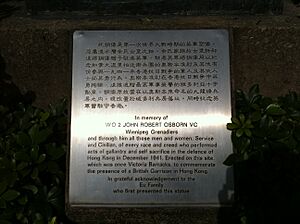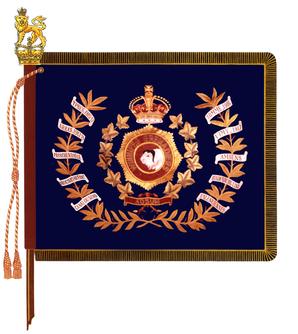Winnipeg Grenadiers facts for kids
Quick facts for kids The Winnipeg Grenadiers |
|
|---|---|
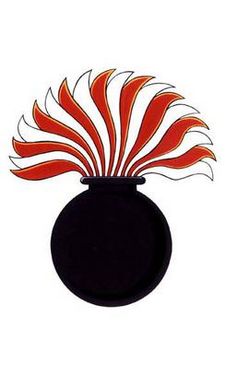
Regimental badge
|
|
| Active | 1 April 1908 – 28 February 1965 |
| Country | |
| Branch | Canadian Militia (1908-1940) |
| Type | Line infantry |
| Role | Infantry |
| Size | 1 battalion |
| Part of | Non-Permanent Active Militia (1871-1940) Royal Canadian Infantry Corps (1940-1965) |
| Garrison/HQ | Minto Armoury, Winnipeg, Manitoba |
| Motto(s) | Latin: Adsum, lit. 'Present' |
| March | "British Grenadiers" |
| Anniversaries | Battle of Hong Kong |
| Engagements | First World War Second World War |
| Battle honours | See § Battle honours |
The Winnipeg Grenadiers was a famous infantry regiment in the Canadian Army. An infantry regiment is a group of soldiers who fight mainly on foot.
This regiment was first created on April 1, 1908, in Morden, Manitoba. It started with eight smaller groups called companies, located in different towns in Manitoba. At first, there were no active soldiers in the unit.
In 1910, all the companies and the main office moved to Winnipeg. On May 2, 1910, the unit's name changed to the 100th Winnipeg Grenadiers. The first officers joined the regiment later that month. The regiment was reorganized in 1915 to have four companies.
Contents
A Brief History of the Winnipeg Grenadiers
The Winnipeg Grenadiers started as the 100th Regiment in Morden, Manitoba, on April 1, 1908. Its name changed several times over the years.
On May 2, 1910, it became the 100th "Winnipeg Grenadiers". Then, on March 12, 1920, it was simply called The Winnipeg Grenadiers.
In 1936, it joined with another unit, the 10th Machine Gun Battalion. After this, it was known as The Winnipeg Grenadiers (Machine Gun). During the Second World War, it had different names like the 1st Battalion and 2nd (Reserve) Battalion.
Finally, on January 28, 1946, it went back to being called The Winnipeg Grenadiers. The regiment officially stopped being an active unit on February 28, 1965.
Honoring Past Units
The Winnipeg Grenadiers carried on the history and traditions of several older Canadian units. These included the 11th Battalion, the 78th Battalion (Winnipeg Grenadiers), and the 100th Battalion (Winnipeg Grenadiers) from the First World War. This means they kept the legacy of these brave soldiers alive.
The Grenadiers in Action
Fighting in the First World War
When the First World War began in August 1914, soldiers from the 100th Winnipeg Grenadiers helped protect local areas.
Many new battalions (large groups of soldiers) were formed to fight overseas.
- The 11th Battalion, CEF (Canadian Expeditionary Force) was created in August 1914. It went to Great Britain to train. Later, it helped send new soldiers to the front lines.
- The 78th Battalion (Winnipeg Grenadiers), CEF was formed in July 1915. They traveled to Great Britain and then to France in August 1916. This battalion fought bravely in France and Belgium until the war ended.
- The 100th Battalion (Winnipeg Grenadiers), CEF was created in December 1915. They also went to Great Britain to train and provide new soldiers for the Canadian forces fighting in Europe.
A Story of Courage: Curley Christian
One amazing soldier from the 78th Battalion was Ethelbert "Curley" Christian. He was badly wounded during the Battle of Vimy Ridge in 1917. He lost both his arms and both his legs.
Despite his severe injuries, Curley Christian survived. He was the only soldier in either the First or Second World War to lose all four limbs and live. He passed away on March 15, 1954, after living many years as a symbol of incredible strength.
Fighting in the Second World War
When the Second World War started on September 1, 1939, the Winnipeg Grenadiers prepared for action. They were called The Winnipeg Grenadiers (Machine Gun), CASF (Canadian Active Service Force).
From May 1940 to October 1941, the regiment served in the Caribbean. They were stationed in Jamaica and Bermuda to help protect these areas. A small group also went to Aruba.
The Battle of Hong Kong

On October 27, 1941, the Winnipeg Grenadiers were sent to Hong Kong as part of "C Force." They arrived there in November. Hong Kong was a British colony, and the Grenadiers were sent to help defend it from Japanese attack.
The Battle of Hong Kong began on December 8, 1941. The Grenadiers fought fiercely for 17 days against a much larger Japanese army. Despite their bravery, the colony fell on December 25, 1941. Many Grenadiers were killed or captured during this battle.
A Hero: John Robert Osborn
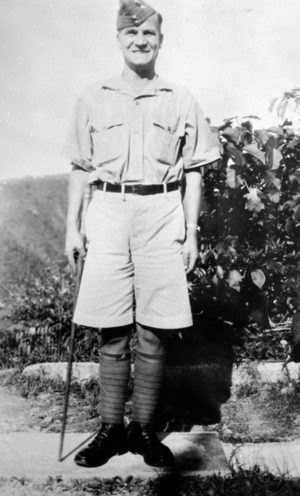
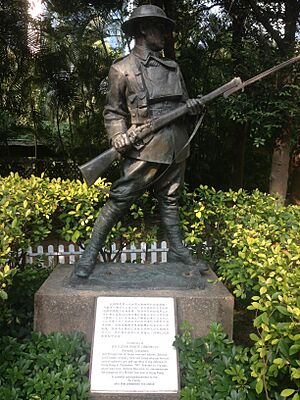
Company Sergeant-Major John Robert Osborn was a 42-year-old soldier in "A" Company of the Winnipeg Grenadiers. He showed incredible courage during the Battle of Hong Kong.
On December 19, 1941, his unit was under heavy attack. A Japanese grenade landed near his fellow soldiers, and there was no time to throw it away. John Robert Osborn shouted a warning and then bravely threw himself on the grenade. The explosion killed him instantly.
His selfless act saved the lives of many of his comrades. For his amazing bravery, he was awarded the Victoria Cross, the highest military honor for courage. His actions were an inspiring example of heroism during the defense of Hong Kong.
Back Home and Training
After the terrible battle in Hong Kong, the 1st Battalion of the Winnipeg Grenadiers was reformed on January 10, 1942. They then served in Canada, helping to defend the country.
In 1943, they took part in an expedition to Kiska, Alaska. This was a mission to retake an island that had been occupied by Japanese forces.
In May 1944, the battalion sailed to Great Britain. There, they became part of a training unit called the 3rd Canadian Infantry Training Battalion. This unit helped prepare new soldiers for combat. The training unit was later disbanded in January 1946.
Regimental Friends
The Winnipeg Grenadiers had special connections with other military units. These connections are called "alliances."
In 1914, they formed an alliance with the Prince of Wales's Leinster Regiment (Royal Canadians). This was an Irish regiment that had Canadian roots.
Since 1933, the Winnipeg Grenadiers have had an alliance with the Scots Guards. This is a famous regiment in the British Army. These alliances help units share traditions and history.
Battle Honors
Battle honors are special awards given to military units for their bravery and success in battles or campaigns. They are often displayed on the unit's flags, called "colours." The Winnipeg Grenadiers earned many battle honors for their service in both World Wars.
First World War Honors
- Ypres, 1915, '17
- Festubert, 1915
- Mount Sorrel
- Somme, 1916
- Ancre Heights
- Ancre, 1916
- Arras, 1917, '18
- Vimy, 1917
- Hill 70
- Passchendaele
- Amiens
- Scarpe, 1918
- Drocourt–Quéant
- Hindenburg Line
- Canal du Nord
- Valenciennes
- Sambre
- France and Flanders, 1915–18
Second World War Honors
Cadet Corps
The Winnipeg Grenadiers also had a cadet corps, which is a youth program that teaches young people about military traditions and leadership.
The first cadet corps was formed on February 15, 1917. It was called the 526 100th Grenadiers Cadet Corps. This group was active until November 13, 1931.
After the Second World War, members of the regiment worked to bring the cadet corps back. On October 1, 1946, the 526 The Winnipeg Grenadiers Cadet Corps was officially restarted. Today, the cadet corps still meets at Minto Armoury in Winnipeg, continuing the traditions of the Grenadiers.
Images for kids




